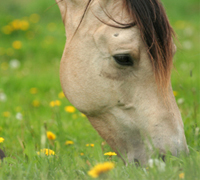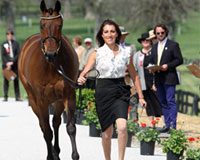 Did you know that there are literally hundreds of different proteins in a horse’s body? Dr. Juliet Getty offers this mini-lesson to help the horse owner or caretaker understand the importance of feeding high-quality protein to optimize the horse’s health.
Did you know that there are literally hundreds of different proteins in a horse’s body? Dr. Juliet Getty offers this mini-lesson to help the horse owner or caretaker understand the importance of feeding high-quality protein to optimize the horse’s health.
The horse’s body prioritizes its protein use: The vital organs (i.e. heart, liver, kidneys, and lungs) are first in line, followed by other important organs such as the pancreas, spleen, digestive tract, bone marrow, adrenal and pituitary glands. The skin, hooves, joints, eyes, and hair wait in line, only receiving amino acids they need once the priority tissues have been fed. (This makes these areas a window to the inside of the horse—if these tissues are in good health, there’s a good chance the horse is doing well on the inside.) The body needs high-quality protein to satisfy the needs of all these organs. And by the way, contrary to popular opinion, protein does not cause laminitis.
A diet of one kind of grass, day in and day out, without any other source of protein, will inevitably lack some of the necessary amino acids, and therefore will supply only a poor quality of protein. It is best to combine grasses and legumes.
Provide 1.5 to 3.5% of your horse’s weight as mixed forages (grasses plus legumes such as alfalfa and clover). Alfalfa is higher in protein than grass hays, but in moderate quantity it boosts the overall protein quality, is low in sugar, and supplies additional minerals. Alfalfa should be mixed (no more than 50%) with grasses to keep protein levels in check and prevent intestinal enterolith formation.
Protein is too important to the horse’s well-being to be taken for granted. Make sure to follow a feeding plan that incorporates high-quality protein.
Further Reading
All About Hay
Seven Feeding Myths Shattered
Meeting Your Horse’s Nutritional Needs
Find out more about this key nutrient in Dr. Getty’s comprehensive guide to equine nutrition, Feed Your Horse Like A Horse, available in hardcover and CD-ROM (pdf format) through the website link below or from Amazon.com.
Dr. Juliet Getty has taught and consulted on equine nutrition for more than 20 years. The Getty Equine Nutrition website (www.GettyEquineNutrition.com) offers helpful articles, a nutrition forum and a calendar of her events. And sign up at the website for her free and informative monthly e-newsletter, “Forage for Thought.” Dr. Getty serves as a distinguished advisor to the Equine Sciences Academy, and she is also available for individual consultations. Reach Dr. Getty directly at gettyequinenutrition@gmail.com or (970) 884-7187.






t
That was very interesting and makes me want to know more. I was alway taught that horses body’s could not handle Alfalfa. I will have to read on this more.
informative need more articles like this
Thanks! I was unaware of the “protein hierarchy” for organs.
Good to know more about equine nutrition.